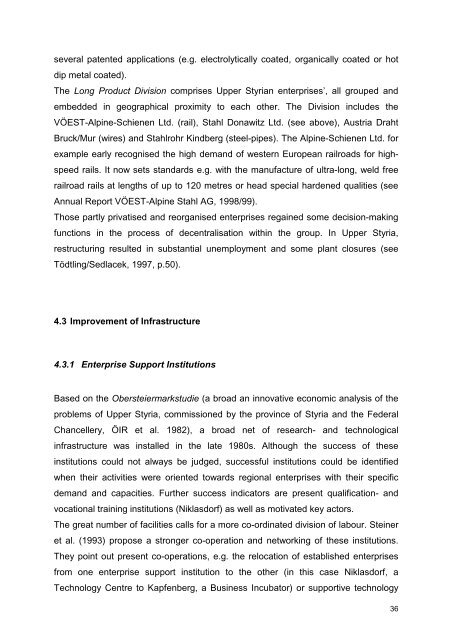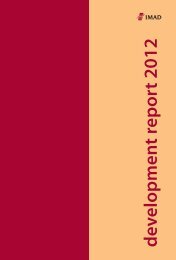Institutional Change in Old Industrial Areas – Lessons for ... - UMAR
Institutional Change in Old Industrial Areas – Lessons for ... - UMAR
Institutional Change in Old Industrial Areas – Lessons for ... - UMAR
Create successful ePaper yourself
Turn your PDF publications into a flip-book with our unique Google optimized e-Paper software.
several patented applications (e.g. electrolytically coated, organically coated or hot<br />
dip metal coated).<br />
The Long Product Division comprises Upper Styrian enterprises’, all grouped and<br />
embedded <strong>in</strong> geographical proximity to each other. The Division <strong>in</strong>cludes the<br />
VÖEST-Alp<strong>in</strong>e-Schienen Ltd. (rail), Stahl Donawitz Ltd. (see above), Austria Draht<br />
Bruck/Mur (wires) and Stahlrohr K<strong>in</strong>dberg (steel-pipes). The Alp<strong>in</strong>e-Schienen Ltd. <strong>for</strong><br />
example early recognised the high demand of western European railroads <strong>for</strong> highspeed<br />
rails. It now sets standards e.g. with the manufacture of ultra-long, weld free<br />
railroad rails at lengths of up to 120 metres or head special hardened qualities (see<br />
Annual Report VÖEST-Alp<strong>in</strong>e Stahl AG, 1998/99).<br />
Those partly privatised and reorganised enterprises rega<strong>in</strong>ed some decision-mak<strong>in</strong>g<br />
functions <strong>in</strong> the process of decentralisation with<strong>in</strong> the group. In Upper Styria,<br />
restructur<strong>in</strong>g resulted <strong>in</strong> substantial unemployment and some plant closures (see<br />
Tödtl<strong>in</strong>g/Sedlacek, 1997, p.50).<br />
4.3 Improvement of Infrastructure<br />
4.3.1 Enterprise Support Institutions<br />
Based on the Obersteiermarkstudie (a broad an <strong>in</strong>novative economic analysis of the<br />
problems of Upper Styria, commissioned by the prov<strong>in</strong>ce of Styria and the Federal<br />
Chancellery, ÖIR et al. 1982), a broad net of research- and technological<br />
<strong>in</strong>frastructure was <strong>in</strong>stalled <strong>in</strong> the late 1980s. Although the success of these<br />
<strong>in</strong>stitutions could not always be judged, successful <strong>in</strong>stitutions could be identified<br />
when their activities were oriented towards regional enterprises with their specific<br />
demand and capacities. Further success <strong>in</strong>dicators are present qualification- and<br />
vocational tra<strong>in</strong><strong>in</strong>g <strong>in</strong>stitutions (Niklasdorf) as well as motivated key actors.<br />
The great number of facilities calls <strong>for</strong> a more co-ord<strong>in</strong>ated division of labour. Ste<strong>in</strong>er<br />
et al. (1993) propose a stronger co-operation and network<strong>in</strong>g of these <strong>in</strong>stitutions.<br />
They po<strong>in</strong>t out present co-operations, e.g. the relocation of established enterprises<br />
from one enterprise support <strong>in</strong>stitution to the other (<strong>in</strong> this case Niklasdorf, a<br />
Technology Centre to Kapfenberg, a Bus<strong>in</strong>ess Incubator) or supportive technology<br />
36
















